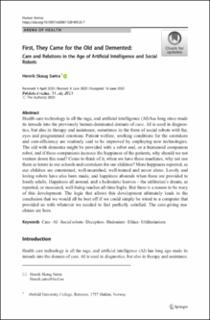First, They Came for the Old and Demented: Care and Relations in the Age of Artificial Intelligence and Social Robots
Peer reviewed, Journal article
Published version
Permanent lenke
https://hdl.handle.net/11250/2676061Utgivelsesdato
2020-07-04Metadata
Vis full innførselSamlinger
Sammendrag
Health care technology is all the rage, and artificial intelligence (AI) has long since made its inroads into the previously human-dominated domain of care. AI is used in diagnostics, but also in therapy and assistance, sometimes in the form of social robots with fur, eyes and programmed emotions. Patient welfare, working conditions for the caretakers and cost-efficiency are routinely said to be improved by employing new technologies.The old with dementia might be provided with a robot seal, or a humanoid companion robot, and if these companions increase the happiness of the patients, why should we not
venture down this road? Come to think of it, when we have these machines, why not use them as tutors in our schools and caretakers for our children? More happiness reported, as our children are entertained, well-nourished, well-trained and never alone. Lovely and loving robots have also been made, and happiness abounds when these are provided to lonely adults. Happiness all around, and a hedonistic heaven – the utilitarian’s dream, as reported, or measured, well-being reaches all-time highs. But there is a reason to be wary of this development. The logic that allows this development ultimately leads to the
conclusion that we would all be best off if we could simply be wired to a computer that provided us with whatever we needed to feel perfectly satisfied. The care-giving machines are here.

